Welcome to the Dark Side
My friends keep telling me I’ve joined the Dark Side. They might be right, I do find myself spending far more time floating than hiking nowadays.
But something about it just feels weird. I mean, wilderness travel shouldn’t be this plush – pulling into camp in the early afternoon, enjoying happy hour barefoot on a beach, while someone else makes me dinner, sleeping on 4 inch thick foam pads within an arms reach of a bottomless beer supply.
What’s not to like? River trips are the shit.
But they are also a massive pain in the ass. It takes crazy amounts of coordination, a literal ton of gear, menus with four course meals, ridiculous car shuttles, permits. You unload hundreds of pounds of gear every day to set up a kitchen complete with three tables and four-burner stoves and sixteen person awnings and an hors d’oeuvre spread next to the happy hour table with a more complete bar than I keep in my house, along with a fancy groover capable of carrying the entire group’s drunken shits out of the canyon, with a massive firepan that will keep the party going until early morning, only to wake up hungover, load all that gear back onto the rafts to float a couple hours down to the next camp and do it all over again.
It’s kinda like car camping, only worse. I’ve never brought this much shit car camping.
The first time I did the Middle Fork of the Salmon, our crew arrived at the Boundary Creek put-in at Stoke Level 10. Holy shit, there were at least 30 other boats launching that same day, with passenger counts nearing triple digits. The eddy at the bottom of the ramp was stacked 4 deep with boats all tied off to one another. A small grip of trip leaders rendezvoused with the Ranger to play ro-sham-bo for the most prized campsites, and outline exactly where every single group would be camping for the next 7 nights.
I scratched my head. Wilderness trip? Maybe not, but my friends promised once we launched we’d forget all about it. This is the price of admission to the Dark Side.
Turns out, they were right. We had an awesome 7 days on the river, relaxed in mind-blowing hot springs, camped on immaculate riverside beaches, ate incredible meals, and blissed out to a level of comfort and luxury that is only possible on a rafting trip.
But in the back of my mind, I kept thinking, “There’s gotta be an easier way.”
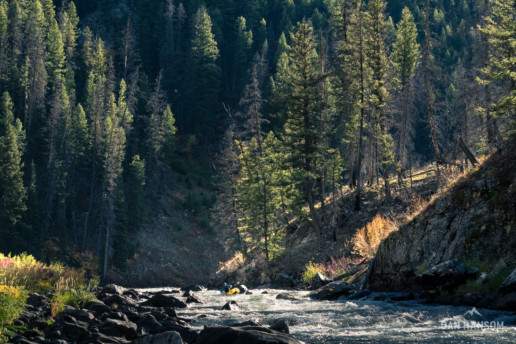
The Chutes – one of the trickiest rapids to negotiate at low water for a raft, made far more simple in a packraft.
Low Water
It’s not hard to avoid the mayhem of peak permit season on the Middle Fork. One option is to target the insanity of a high water trip. There’s only a handful of skilled boaters who can pull it off, so competition is limited. For mere mortals like myself, that’s not a very practical option. The more sensible option is to plan a low water trip.
This is not without it’s own challenges. The weather is colder and less stable, the days are shorter, and the first 25 miles are painfully bony and thin. The only way to get a raft down it is to leave a ton of gear behind. Or fly some extra gear into Indian Creek to pick up two days down river. It definitely means you carry less beer.
The flip side though is much smaller crowds, an easier to get permit, and certainly a more wilderness feel.
So when Mark Oates (of Tasmania fame) scored a late-season permit with an eye toward an 8 day fully self-supported packraft trip, I did everything possible to invite myself, hoping a more simple trip would give me a different perspective of the place.
The real question, how comfortable can an 8 day trip with a 9 pound boat really be?
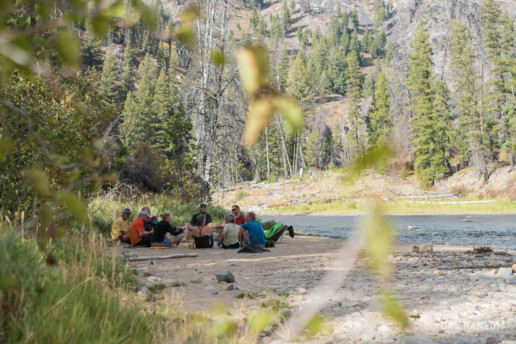
Low water beach camp at Sheepeater. Doesn’t get much better than this.
Lightweight Gear
The Middle Fork is definitely not a traditional packrafting river. Packrafts are designed for the backcountry where a lightweight portable boat is the priority. Recent models have evolved to the point though where they do a pretty damn good job with “slackcountry” trips as well – the ones where it is possible to get away with carrying a lot more gear than you’d ever want to hump around on your back.
I’ve owned a couple of packrafts over the years, including a square-butt Alpacka, an Aire Bakraft, and now an Alpacka series self bailer with cargo zip. I had never really considered a big trip like this in a packraft, until I got the Alpacka Self Bailer. It can easily haul a week’s worth of food and gear, (including the mandatory groover system). The cargo zip allows you to clip two drybags with gear inside the tubes of the boar near your hips, which keeps the center of gravity low and dialed. The only downside to a self bailer would be the cold weather late in the trip, constant rain and ambient air temps that require an extra layer of insulation that you could probably skip in a decked boat.
No matter how light you want to go, there are some mandatory pieces required on the Middle Fork, including a fire pan and groover. For a fire pan, we carried a custom made titanium pan that met the minimum dimensions, with a total weight of a couple pounds. For a groover, I strapped an Imlay Canyon Keg to two glued plates inside the butt of the Alpacka, so that when the tubes were fully inflated, the keg rests off the tubes entirely. That setup was super lightweight, and more than sufficient for 8 days. Everything else was basically backpacker style – dehydrated meals, aquamira for water treatment, Hyperlite Ultamid for shelter.
In the end, I couldn’t fully divorce myself from the river-life of luxury, and I tossed in a lightweight collapsible chair from REI. Total luxury item, but oh-so-nice.
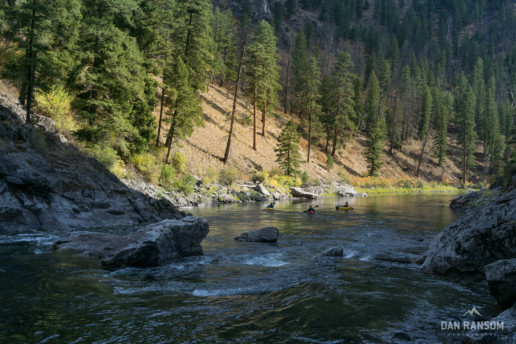
Awesome light at Ski Jump
The First 25 Miles
First things first, I am not an expert boater. I’ve rowed a big boat down a handful of rivers (Grand Canyon multiple times, Lodore, Westwater, Middle Fork, Hell’s) but paddling a packraft is a different game entirely. While the Alpacka is surprisingly stable and maneuverable, it does have a smaller margin for human error. I’d place my comfort level squarely at Class III, and I expected the Middle Fork to stretch that comfort level at least a few times.
This is my first multi-day trip in the new boat, and there wasn’t much time for a warm up – the first rapid starts just a few hundred yards below the put-in, and for the next few hours it is pretty consistent. We launched with 1.5 feet on the gauge, and most beta would describe this stretch as notoriously difficult at these flows. For rafters, that’s entirely accurate. Expect to beat the hell out of your boat (and yourself) as you scrape your way downstream. But for our little inflatable go karts, it’s a rock concert.
At mile 5 is Velvet Falls, a class IV rapid with a nearly riverwide recirculating ledge hole. I remembered this rapid well from my trip at 4 feet, and was sufficiently gripped as I paddled into it. At 1.5 feet, the ledge is much more exposed, but almost all of it’s bite is gone.
The last real challenge before Indian is Pistol Creek. This is one of the legendary rapids on the Middle Fork, in high water it is class IV, with a tight s-curve and some nasty rocks along the right wall. At lower flows it is far less intense, but does require some attention to avoid the one obstacle you have to miss.
I lagged behind our group to photograph Cannon Creek just a mile or so upstream. By the time I made my way to Pistol most of the crew was on the shore with cameras in hand. I put on a helluva show, stuffing my little boat straight into the exact rock I intended to miss. I cartwheeled out of my boat, pretty painful swim in shallow water shelf, but fortunately walked away with just a bruised hip and ego. (at :59 in the video)
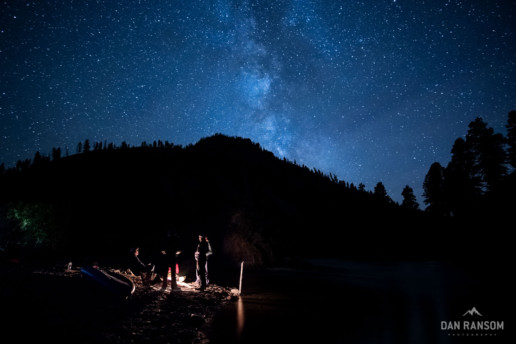
Milky Way above Loon Creek
Below Pistol
The next couple days generally mellow out as more water is added to the main channel from Pistol and Indian Creek. We made the mandatory pitstop at Indian Creek to chat with the river ranger and chat about the permit. We passed a couple groups here rigging rafts who had flown in.
This relatively calm stretch is punctuated by a handful of fun rapids, including Tappan Falls. From the scout, the rapid looks fairly complicated, but we had folks eventually running a handful of different lines that all went. Cove Creek is just below Tappan, and is a fun low water ride with a couple of exposed rocks to avoid up high.
About this same time, a storm moved in that would join consistently dump light rain on us for the rest of the trip. Temperatures dropped, and overnight snow dusted the upper ridges of the canyon. Wet and cold, we hoped to make some miles and set ourselves up for a daytrip on Big Creek the next day, when we got caught sleeping. Just below Flying B is a long rock garden called Haystack. Our first boat through flipped, and took a long cold swim all the way to the bottom.
Score one point for mid-summer trips when warming up is certainly a lot easier.
Big Creek
Big Creek is the largest tributary of the Middle Fork, and itself a worthy destination for kayakers. Most folks avoid the uncomfortable logistics of getting their on foot, and fly into the airstrip, and paddle 35 or so miles back to the confluence.
This late in the season, we had our sights on the 4 miles from Soldier Bar, through the gorge, and back to the confluence. We stashed our drybags and gear at the bottom, rolled up the packrafts, and made a quick 90 minute hike to the top. This also gives you the advantage of scouting the entire run on the way up.
At higher flows, this stretch could easily be above my paygrade. But with just a couple hundred CFS, the water was not very pushy, and ended up being the best stretch of paddling of the entire trip.
Impassable Canyon
Below Big Creek, the canyon dramatically changes character, as it cuts through the Impassable Canyon. These last 20 miles are well known for their whitewater, but the scenery is even better.
This section has more of a pool drop feel, with a handful of really fun rapids like Weber, Rubber, and Hancock. At these flows they were fairly straightforward read and run. Surprisingly, the biggest waves of the entire trip were in Cliffside, where most of the flow piles up on the wall on river left, creating a massive wave train.
Our last bit of adventure came in Devil’s Tooth. At low water, the tooth creates a nice hole dead center in the river channel, and will instantly flip the dude asleep at the wheel. I got a nice recirculating wash in the hole, before finally getting spit out.
Those last few miles of Impassable Canyon are insane, my photos just don’t do it justice. And then just like that, you round a bend, the canyon relents, and you are on the Main Salmon.
I’ve now seen the Middle Fork twice, both times completely different experiences. Hard to say one is better than the other, both are pretty damn good.
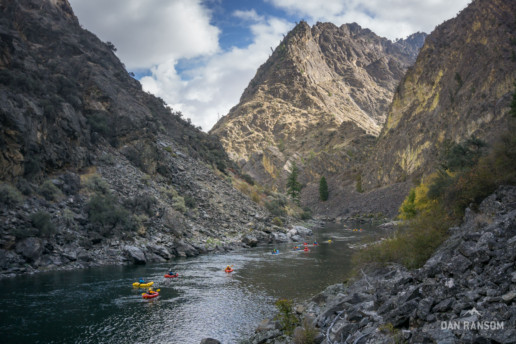
UPDATE 7/19/2017
After a few years of prototypes, Tom at Suspicious Devices (who built our prototype fire pans) is nearly ready to release his titanium pan. 
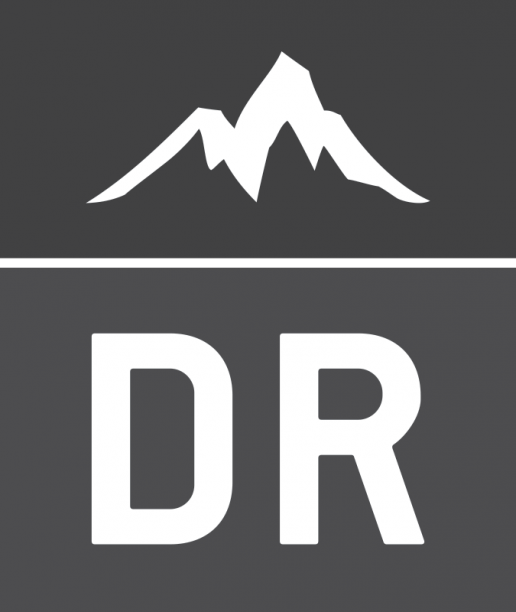
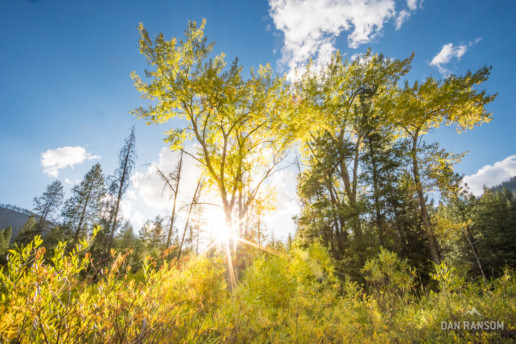
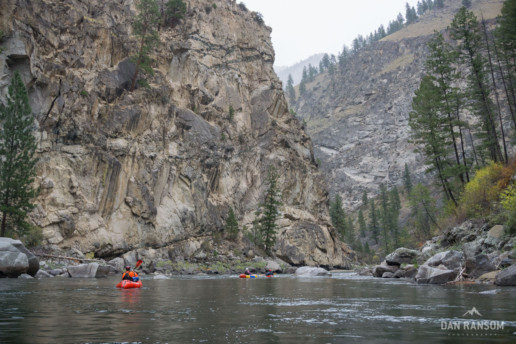
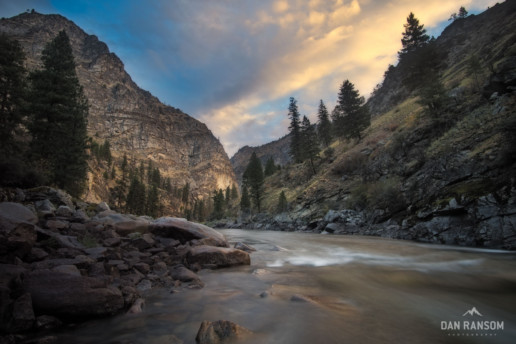
That looks like quite the crew. Good report.
I’d love to see your groover setup with the Imlay Canyon Keg. Sounds like you store it inside the cargo zip? Can you show a picture of the plate you are talking about?
Hey Nathan, check these out. The plates are from Alpacka, allow a cam strap to slip through them.
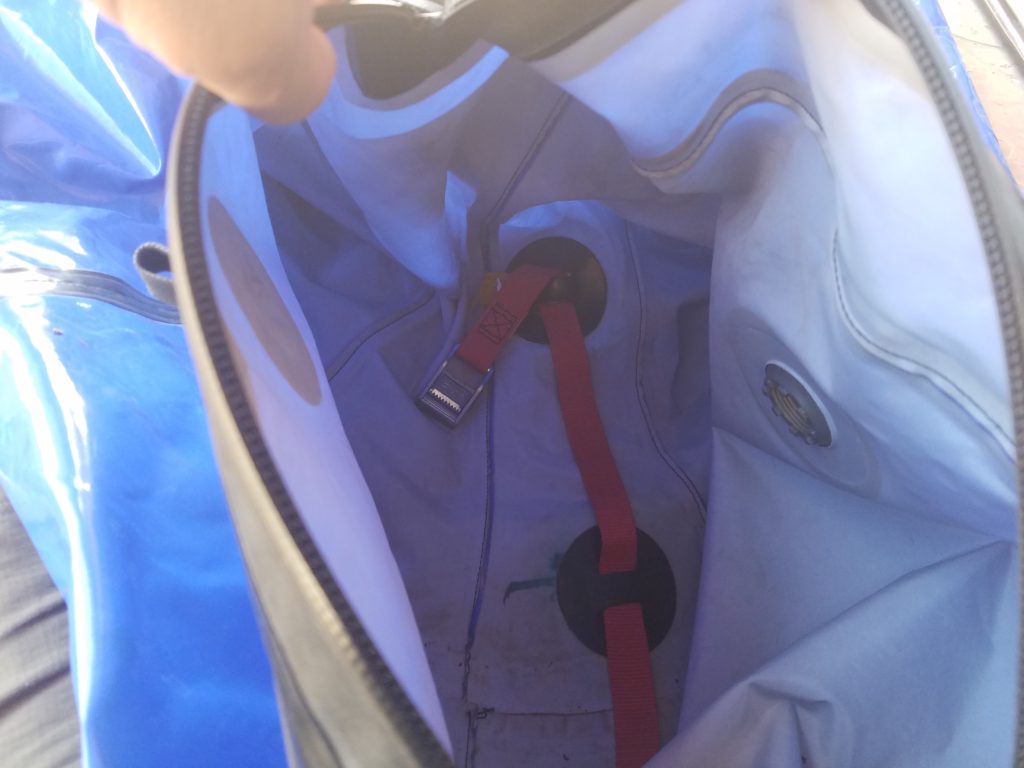
Oh, awesome! Thanks for the info.
What’s the advantage of strapping it down, rather than just setting it in the bow of the boat?
1 – In a flip, a loose can of poop floating down the river isn’t ideal. 2 – inside is out of the way, carries better and is more secure.
Great photo essay Dan! The filming was great too. I probably would love the scenery but hate the cold 🙂
Haha, we just had a late launch. It is actually surprisingly warm there. I think the take-out is like 3,000 feet. So even in September it’s nice.
Beautiful trip report Dan! Thank you.
Would you be willing to share your Ti firepan design?
Awesome trip report! When in September did you go? I have a late September MF launch and am trying to pull something similar together.
We launched September 28th.
Dan I am curious if you glued those strap plates on yourself? If so what kind of glue/adhesive material did you use to attach those strap plates to the interior tube fabric of your packraft? Thanks for any help you can provide